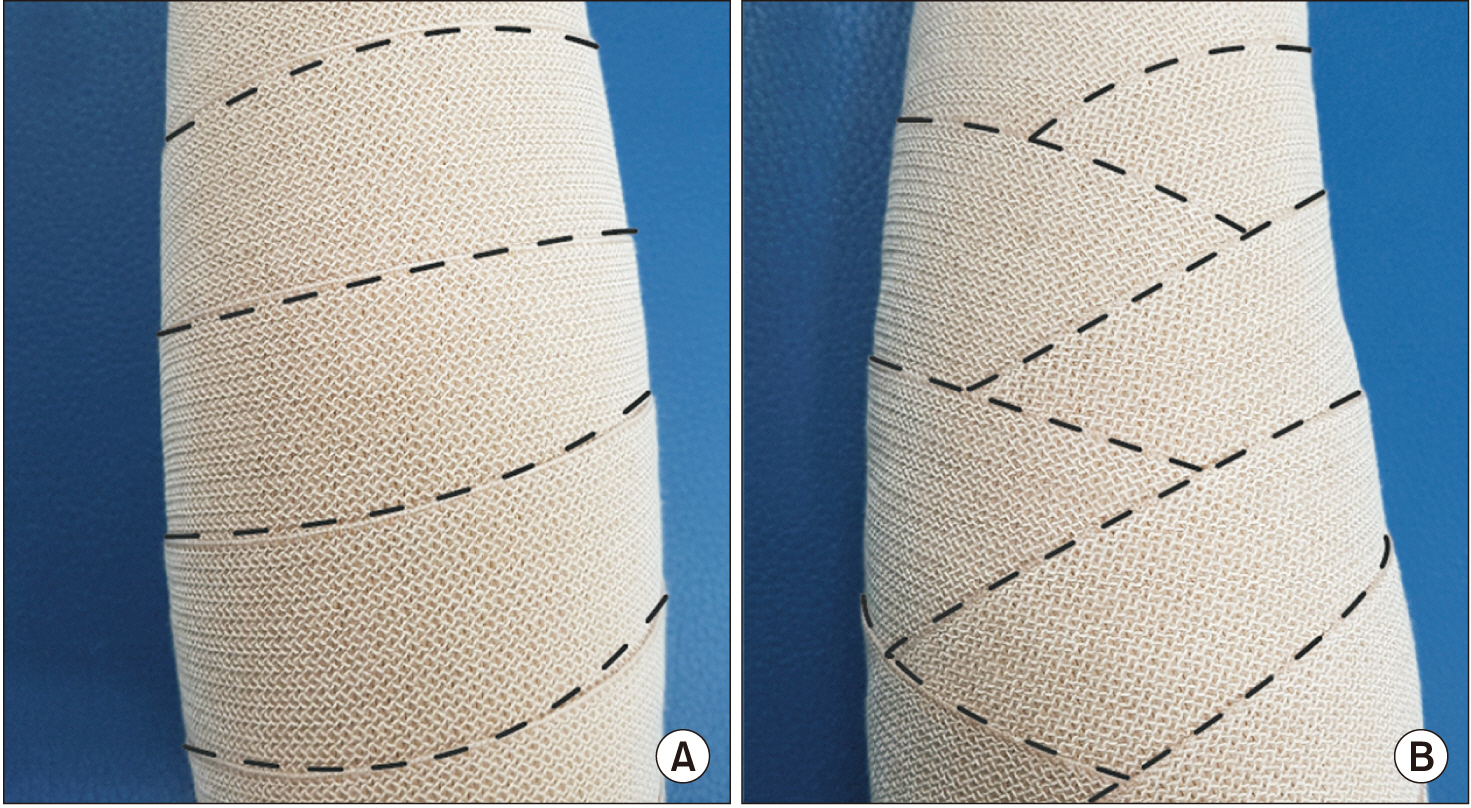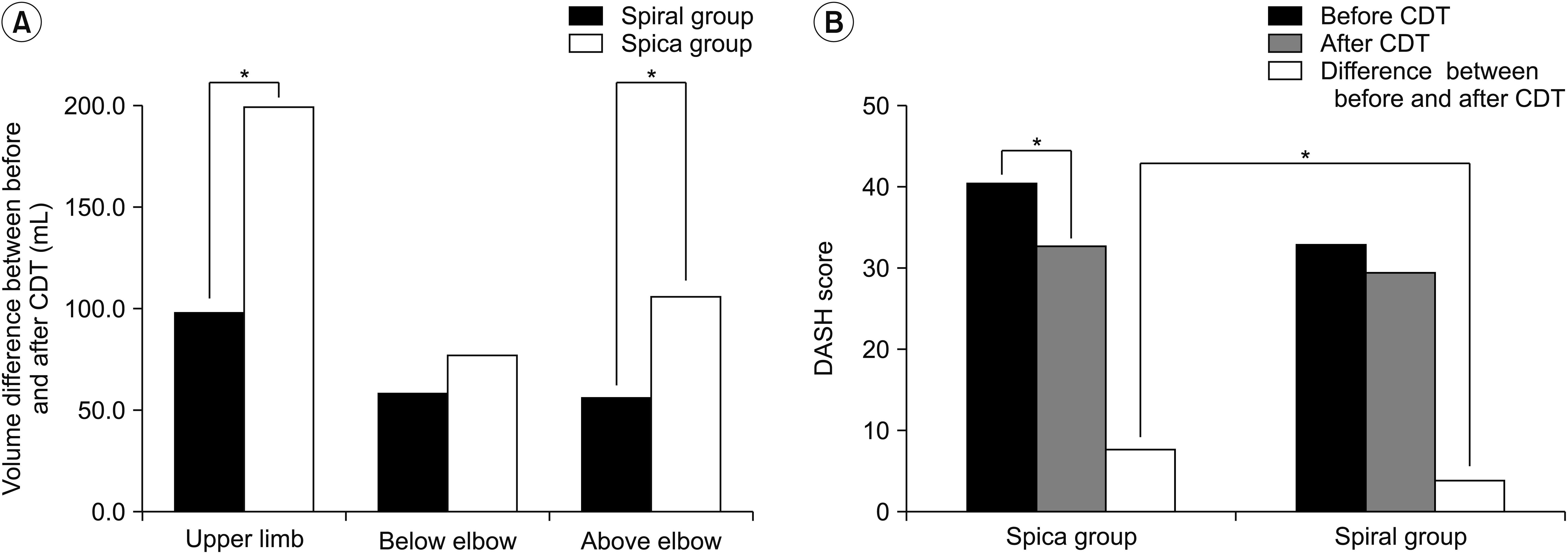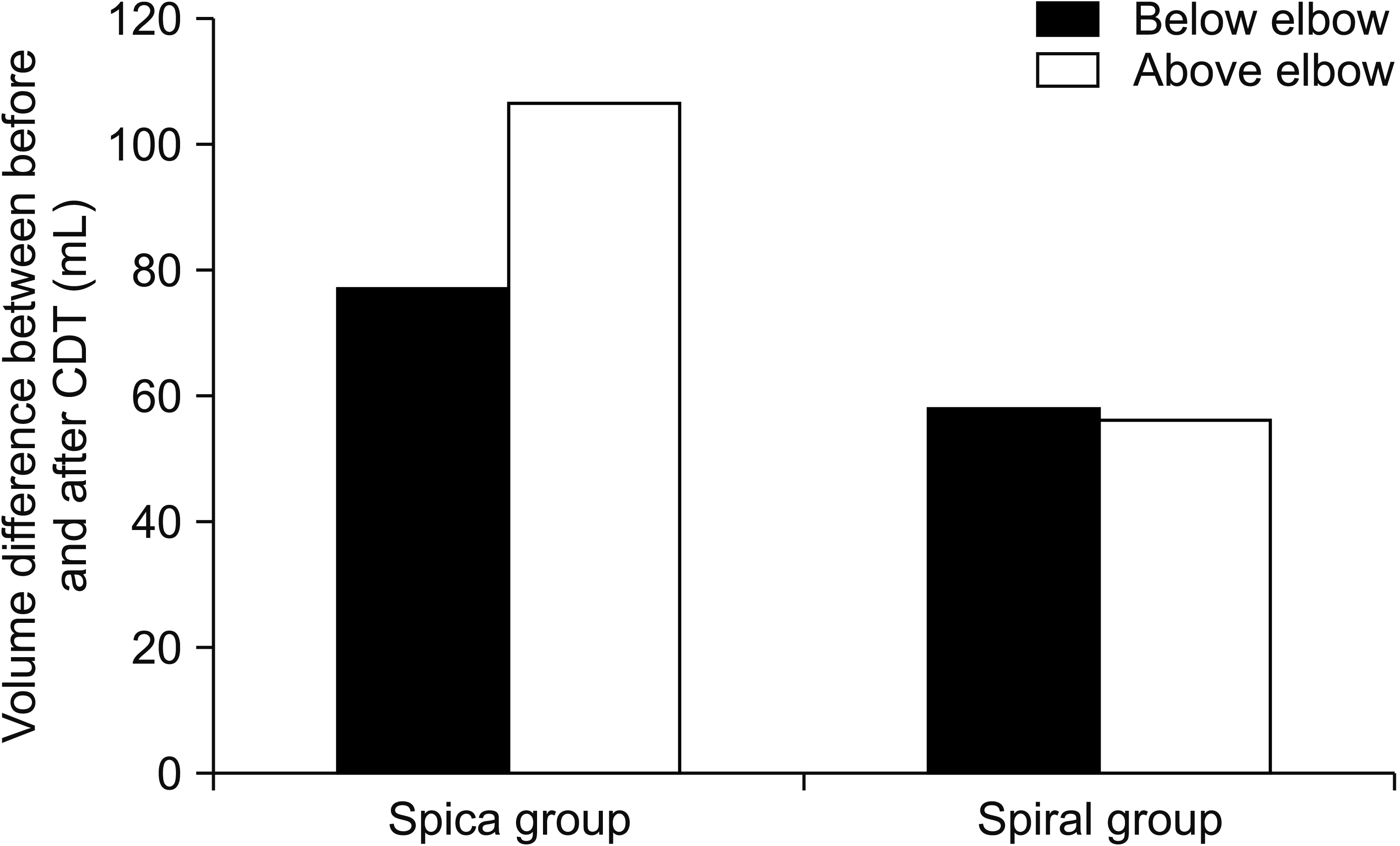Ann Rehabil Med.
2019 Dec;43(6):677-685. 10.5535/arm.2019.43.6.677.
Effects of Different Bandaging Methods for Treating Patients With Breast Cancer-Related Lymphedema
- Affiliations
-
- 1Department of Physical Medicine and Rehabilitation, Kosin University Gospel Hospital, Busan, Korea. oggum@naver.com
- 2Department of Pediatrics, Kosin University Gospel Hospital, Busan, Korea.
- KMID: 2468694
- DOI: http://doi.org/10.5535/arm.2019.43.6.677
Abstract
OBJECTIVE
To compare the treatment effects, satisfaction with the treatment, and performance improvement following bandage treatment using the spiral method and spica method for breast cancer-related lymphedema (BCRL).
METHODS
A prospective study with 46 patients with BCRL was conducted. All patients were divided into either the spiral or spica group for non-elastic bandage therapy and received the same treatment for 2 weeks, apart from the group-specific bandaging method used. For both groups, the Quality of Life Instrument score before treatment, changes in the volume of lymphedema limb and the Disability of the Arm, Shoulder, and Hand (DASH) score before and after treatment, and treatment satisfaction after treatment were compared. The Student t-test was used to compare the parameters between the two different bandage methods.
RESULTS
With respect to the treatment outcomes, total volume reduction and proximal part volume reduction after treatment were 98.0±158.3 mL and 56.0±65.4 mL in the spiral method group and 199.0±125.1 mL and 106.1±82.2 mL in the spica method group, respectively. Therefore, the spica method group showed a significantly better improvement (p < 0.05). The DASH score changes after treatment showed that the spiral group score increased by 3.8±5.4 and the spica group score increased by 7.7±6.1; thus, a significantly better improvement was noted in the spica group (p < 0.05).
CONCLUSION
The spica method indicated better volume reduction and DASH score improvement than the spiral method. Therefore, the spica method may be more effective for treating patients with BCRL.
Keyword
MeSH Terms
Figure
Cited by 2 articles
-
Recent Trends in Rehabilitation for Cancer Patients
Kwan-Sik Seo
Ann Rehabil Med. 2022;46(3):111-113. doi: 10.5535/arm.22072.The effects of complex decongestive therapy on pain and functionality in individuals with breast cancer who developed adhesive capsulitis due to lymphedema: an evaluation by an isokinetic computerized system
Konca Kaya Tatar, Begumhan Turhan
Korean J Pain. 2022;35(3):280-290. doi: 10.3344/kjp.2022.35.3.280.
Reference
-
1. Kim SJ, Yi CH, Kwon OY. Effect of complex decongestive therapy on edema and the quality of life in breast cancer patients with unilateral leymphedema. Lymphology. 2007; 40:143–51.2. Kim DS, Sim YJ, Jeong HJ, Kim GC. Effect of active resistive exercise on breast cancer-related lymphedema: a randomized controlled trial. Arch Phys Med Rehabil. 2010; 91:1844–8.
Article3. King M, Deveaux A, White H, Rayson D. Compression garments versus compression bandaging in decongestive lymphatic therapy for breast cancer-related lymphedema: a randomized controlled trial. Support Care Cancer. 2012; 20:1031–6.
Article4. Tsai HJ, Hung HC, Yang JL, Huang CS, Tsauo JY. Could Kinesio tape replace the bandage in decongestive lymphatic therapy for breast-cancer-related lymphedema? A pilot study. Support Care Cancer. 2009; 17:1353–60.
Article5. Kligman L, Wong RK, Johnston M, Laetsch NS. The treatment of lymphedema related to breast cancer: a systematic review and evidence summary. Support Care Cancer. 2004; 12:421–31.
Article6. Karki A, Anttila H, Tasmuth T, Rautakorpi UM. Lymphoedema therapy in breast cancer patients: a systematic review on effectiveness and a survey of current practices and costs in Finland. Acta Oncol. 2009; 48:850–9.7. Badger C, Preston N, Seers K, Mortimer P. Physical therapies for reducing and controlling lymphoedema of the limbs. Cochrane Database Syst Rev. 2004; (4):CD003141.
Article8. Armer JM, Stewart BR. A comparison of four diagnostic criteria for lymphedema in a post-breast cancer population. Lymphat Res Biol. 2005; 3:208–17.
Article9. Ridner SH. Quality of life and a symptom cluster associated with breast cancer treatment-related lymphedema. Support Care Cancer. 2005; 13:904–11.
Article10. Zuther JE. Pathology: documentation techniques for lymphedema. In : Zuther JE, editor. Lymphedema management: the comprehensive guide for practitioners. 2nd ed. New York: Thieme;2005. p. 127–9.11. Taylor R, Jayasinghe UW, Koelmeyer L, Ung O, Boyages J. Reliability and validity of arm volume measurements for assessment of lymphedema. Phys Ther. 2006; 86:205–14.
Article12. Clark B, Sitzia J, Harlow W. Incidence and risk of arm oedema following treatment for breast cancer: a threeyear follow-up study. QJM. 2005; 98:343–8.
Article13. Ryu SH, Min SW, Kim JH, Jeong HJ, Kim GC, Kim DK, et al. Diagnostic significance of fibrin degradation products and D-dimer in patients with breast cancerrelated lymphedema. Ann Rehabil Med. 2019; 43:81–6.
Article14. Levenhagen K, Davies C, Perdomo M, Ryans K, Gilchrist L. Diagnosis of upper quadrant lymphedema secondary to cancer: clinical practice guideline from the oncology section of the American Physical Therapy Association. Phys Ther. 2017; 97:729–45.
Article15. Kim P, Lee JK, Lim OK, Park HK, Park KD. Quantitative lymphoscintigraphy to predict the possibility of lymphedema development after breast cancer surgery: retrospective clinical study. Ann Rehabil Med. 2017; 41:1065–75.
Article16. Kim L, Jeon JY, Sung IY, Jeong SY, Do JH, Kim HJ. Prediction of treatment outcome with bioimpedance measurements in breast cancer related lymphedema patients. Ann Rehabil Med. 2011; 35:687–93.
Article17. Didem K, Ufuk YS, Serdar S, Zumre A. The comparison of two different physiotherapy methods in treatment of lymphedema after breast surgery. Breast Cancer Res Treat. 2005; 93:49–54.
Article18. Casley-Smith JR, Casley-Smith JR. Modern treatment of lymphoedema. I. Complex physical therapy: the first 200 Australian limbs. Australas J Dermatol. 1992; 33:61–8.
Article19. Matthews K, Smith J. Effectiveness of modified complex physical therapy for lymphoedema treatment. Aust J Physiother. 1996; 42:323–8.
Article20. Damstra RJ, Partsch H. Compression therapy in breast cancer-related lymphedema: a randomized, controlled comparative study of relation between volume and interface pressure changes. J Vasc Surg. 2009; 49:1256–63.
Article21. Partsch H, Clark M, Mosti G, Steinlechner E, Schuren J, Abel M, et al. Classification of compression bandages: practical aspects. Dermatol Surg. 2008; 34:600–9.
Article22. Mayrovitz HN. The standard of care for lymphedema: current concepts and physiological considerations. Lymphat Res Biol. 2009; 7:101–8.
Article23. Benigni JP, Uhl JF, Cornu-Thenard A, Blin E. Compression bandages: influence of techniques of use on their clinical efficiency and tolerance. Int Angiol. 2008; 27:68–73.24. Devoogdt N, De Groef A, Hendrickx A, Damstra R, Christiaansen A, Geraerts I, et al. Lymphoedema Functioning, Disability and Health Questionnaire for Lower Limb Lymphoedema (Lymph-ICF-LL): reliability and validity. Phys Ther. 2014; 94:705–21.
Article25. Viehoff PB, Gielink PD, Damstra RJ, Heerkens YF, van Ravensberg DC, Neumann MH. Functioning in lymphedema from the patients’ perspective using the International Classification of Functioning, Disability and health (ICF) as a reference. Acta Oncol. 2015; 54:411–21.
Article26. Do JH, Kim W, Cho YK, Lee J, Song EJ, Chun YM, et al. Effects of resistance exercises and complex decongestive therapy on arm function and muscular strength in breast cancer related lymphedema. Lymphology. 2015; 48:184–96.27. Ezzo J, Manheimer E, McNeely ML, Howell DM, Weiss R, Johansson KI, et al. Manual lymphatic drainage for lymphedema following breast cancer treatment. Cochrane Database Syst Rev. 2015; (5):CD003475.
Article28. Campanholi LL, Lopes GC, Mansani FP, Bergmann A, Baiocch JM. The validity of an adjustable compression Velcro wrap for the treatment of patients with upper limb lymphedema secondary to breast cancer: a pilot study. Mastology. 2017; 27:206–12.
Article29. International Society of Lymphology. The diagnosis and treatment of peripheral lymphedema: 2013 Consensus Document of the International Society of Lymphology. Lymphology. 2013; 46:1–11.
- Full Text Links
- Actions
-
Cited
- CITED
-
- Close
- Share
- Similar articles
-
- Rapid Lymphedema Progression in Breast Cancer Patient with Previous Forearm Fracture
- Health-Related Quality of Life in Breast Cancer Patients with Lymphedema Who Survived More than One Year after Surgery
- Comparisons of Physiological and Psychosocial Symptoms for Breast Cancer Patients with and without Lymphedema
- Effects of Education Program for Combined Management of Lymphedema with regard to Breast Cancer Patients with Axillary Lymph Node Dissection: A Quasi-Experimental Study
- Quality of Life, Upper Extremity Function and the Effect of Lymphedema Treatment in Breast Cancer Related Lymphedema Patients




